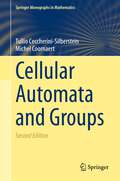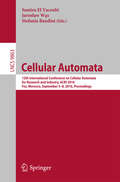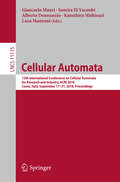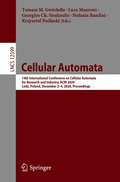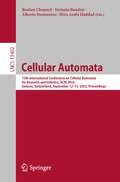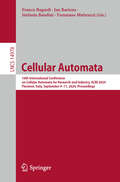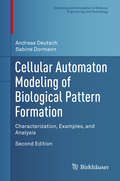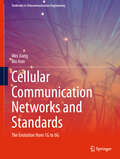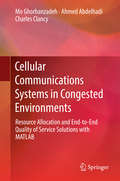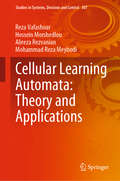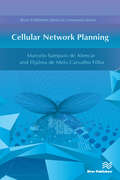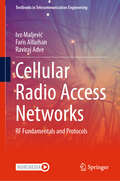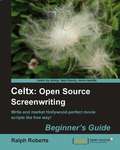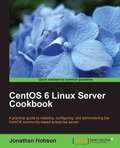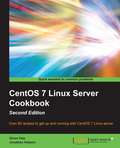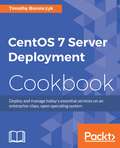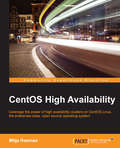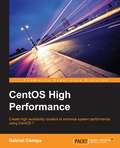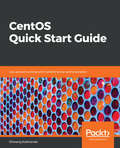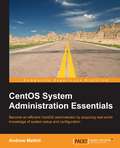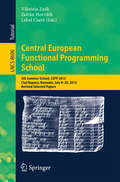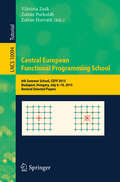- Table View
- List View
Cellular Automata and Groups (Springer Monographs in Mathematics)
by Tullio Ceccherini-Silberstein Michel CoornaertThis unique book provides a self-contained exposition of the theory of cellular automata on groups and explores its deep connections with recent developments in geometric and combinatorial group theory, amenability, symbolic dynamics, the algebraic theory of group rings, and other branches of mathematics and theoretical computer science. The topics treated include the Garden of Eden theorem for amenable groups, the Gromov–Weiss surjunctivity theorem, and the solution of the Kaplansky conjecture on the stable finiteness of group rings for sofic groups. Entirely self-contained and now in its second edition, the volume includes 10 appendices and more than 600 exercises, the solutions of which are presented in the companion book Exercises in Cellular Automata and Groups (2023) by the same authors. It will appeal to a large audience, including specialists and newcomers to the field.
Cellular Automata: 12th International Conference on Cellular Automata for Research and Industry, ACRI 2016, Fez, Morocco, September 5-8, 2016. Proceedings (Lecture Notes in Computer Science #9863)
by Samira El Yacoubi Jaroslaw Wąs Stefania BandiniThis book constitutes the refereed proceedings of the 7th International Conference on Cellular Automata for Research and Industry, ACRI 2006. The book presents 53 revised full papers and 19 revised poster papers together with 6 invited lectures. Topical sections include CA theory and implementation, computational theory, population dynamics, physical modeling, urban, environmental and social modeling, traffic and boolean networks, multi-agents and robotics, as well as crowds and cellular automata, and more.
Cellular Automata: 13th International Conference on Cellular Automata for Research and Industry, ACRI 2018, Como, Italy, September 17–21, 2018, Proceedings (Lecture Notes in Computer Science #11115)
by Giancarlo Mauri Samira El Yacoubi Alberto Dennunzio Luca Manzoni Katsuhiro NishinariThis book constitutes the proceedings of the 13th International Conference on Cellular Automata for Research and Industry, ACRI 2018, held in Como, Italy, in September 2018. The 47 full papers presented in this volume were carefully reviewed and selected from 64 submissions.This volume contains invited contributions and accepted papers from the main track and from the three organized workshops. The volume is organized in the following topics: biological systems modeling; simulation and other applications of CA; multi-agent systems; pedestrian and traffic dynamics; synchronization and control; theory and cryptography; asynchronous cellular automata; and crowds, traffic and cellular automata.
Cellular Automata: 14th International Conference on Cellular Automata for Research and Industry, ACRI 2020, Lodz, Poland, December 2–4, 2020, Proceedings (Lecture Notes in Computer Science #12599)
by Georgios Ch. Sirakoulis Stefania Bandini Luca Manzoni Tomasz M. Gwizdałła Krzysztof PodlaskiThis book constitutes the refereed proceedings of the 14th International Conference on Cellular Automata for Research and Industry, ACRI 2020, which took place in Lodz, Poland, during December 2-4, 2020. The 24 full and 3 short papers presented in this volume were carefully reviewed and selected from 40 submissions. They were organized in topical sections named: theory and cryptography, modeling and simulation, and disease spreading dynamics.
Cellular Automata: 15th International Conference on Cellular Automata for Research and Industry, ACRI 2022, Geneva, Switzerland, September 12–15, 2022, Proceedings (Lecture Notes in Computer Science #13402)
by Stefania Bandini Alberto Dennunzio Bastien Chopard Mira Arabi HaddadThis book constitutes the refereed proceedings of the 15th International Conference on Cellular Automata for Research and Industry, ACRI 2022, which took place in Geneva, Switzerland, in September 2022.The 31 full papers presented in this volume were carefully reviewed and selected from 36 submissions. They were organized in topical sections named: Theory; Modelling and simulation physical systems and phenomena; Cellular automata and spreading dynamics; Crowds, pedestrian and traffic dynamics; Other studies on cellular automata.
Cellular Automata: 16th International Conference on Cellular Automata for Research and Industry, ACRI 2024, Florence, Italy, September 9–11, 2024, Proceedings (Lecture Notes in Computer Science #14978)
by Jan Baetens Franco Bagnoli Stefania Bandini Tommaso MatteuzziThis book constitutes the refereed proceedings of the 16th International Conference on Cellular Automata for Research and Industry, Cellular Automata, ACRI 2024, held in Florence, Italy, in September 9–11, 2024. The 20 full papers presented were carefully reviewed and selected from 33 submissions. They were organized in the following topical sections: theory, mathematical and physical models; computational aspects and applications; social and biological models.
Cellular Automaton Modeling of Biological Pattern Formation: Characterization, Examples, and Analysis (Modeling and Simulation in Science, Engineering and Technology)
by Andreas Deutsch Sabine DormannThis text explores the use of cellular automata in modeling pattern formation in biological systems. It describes several mathematical modeling approaches utilizing cellular automata that can be used to study the dynamics of interacting cell systems both in simulation and in practice. New in this edition are chapters covering cell migration, tissue development, and cancer dynamics, as well as updated references and new research topic suggestions that reflect the rapid development of the field.The book begins with an introduction to pattern-forming principles in biology and the various mathematical modeling techniques that can be used to analyze them. Cellular automaton models are then discussed in detail for different types of cellular processes and interactions, including random movement, cell migration, adhesive cell interaction, alignment and cellular swarming, growth processes, pigment cell pattern formation, tissue development, tumor growth and invasion, and Turing-type patterns and excitable media. In the final chapter, the authors critically discuss possibilities and limitations of the cellular automaton approach in modeling various biological applications, along with future research directions. Suggestions for research projects are provided throughout the book to encourage additional engagement with the material, and an accompanying simulator is available for readers to perform their own simulations on several of the models covered in the text. QR codes are included within the text for easy access to the simulator.With its accessible presentation and interdisciplinary approach, Cellular Automaton Modeling of Biological Pattern Formation is suitable for graduate and advanced undergraduate students in mathematical biology, biological modeling, and biological computing. It will also be a valuable resource for researchers and practitioners in applied mathematics, mathematical biology, computational physics, bioengineering, and computer science.
Cellular Communication Networks and Standards: The Evolution from 1G to 6G (Textbooks in Telecommunication Engineering)
by Wei Jiang Bin HanThis textbook provides a comprehensive review of the evolution of mobile communications and networking from the birth of cellular networks to the forthcoming sixth-generation mobile communications, which is envisioned to be commercially deployed first in 2030. New students who are coming to wireless communications/electrical engineering/computer networking/telecommunications and network engineering can benefit from this book by quickly grasping the whole history of cellular networks, understanding its trends. This tutorial styled textbook provides a comprehensive overview, but also provides details of the system design aspects of the various cellular generations up to 6G and how they build on each other. The book also gives the student an overview of different cellular generations’ motivations, core technologies, architecture, key performance indicators, killer applications, market drivers, and the general/main features of each. The authors capture the big picture and fundamental drivers of wireless communication technologies, and then motivate students to understand the importance of learning related subjects such as electromagnetics theory, antenna design, analog and digital circuits, signal processing, Internet protocols, artificial intelligence, etc. The book features homework questions and case studies throughout.
Cellular Communications Systems in Congested Environments: Resource Allocation and End-to-End Quality of Service Solutions with MATLAB
by Ahmed Abdelhadi Mo Ghorbanzadeh Charles ClancyThis book presents a mathematical treatment of the radio resource allocation of modern cellular communications systems in contested environments. It focuses on fulfilling the quality of service requirements of the living applications on the user devices, which leverage the cellular system, and with attention to elevating the users' quality of experience. The authors also address the congestion of the spectrum by allowing sharing with the band incumbents while providing with a quality-of-service-minded resource allocation in the network. The content is of particular interest to telecommunications scheduler experts in industry, communications applications academia, and graduate students whose paramount research deals with resource allocation and quality of service.
Cellular Learning Automata: Theory and Applications (Studies in Systems, Decision and Control #307)
by Alireza Rezvanian Mohammad Reza Meybodi Reza Vafashoar Hossein MorshedlouThis book highlights both theoretical and applied advances in cellular learning automata (CLA), a type of hybrid computational model that has been successfully employed in various areas to solve complex problems and to model, learn, or simulate complicated patterns of behavior. Owing to CLA’s parallel and learning abilities, it has proven to be quite effective in uncertain, time-varying, decentralized, and distributed environments. The book begins with a brief introduction to various CLA models, before focusing on recently developed CLA variants. In turn, the research areas related to CLA are addressed as bibliometric network analysis perspectives. The next part of the book presents CLA-based solutions to several computer science problems in e.g. static optimization, dynamic optimization, wireless networks, mesh networks, and cloud computing. Given its scope, the book is well suited for all researchers in the fields of artificial intelligence and reinforcement learning.
Cellular Network Planning (River Publishers Series In Communications Ser.)
by Marcelo Sampaio Alencar Djalma de Melo Carvalho FilhoOver the recent years, few books have been published covering all the subjects needed to understand the very fundamental concepts of cell planning. Most books which deal with this topic are destined to very specific audiences, and the vast majority introduce the subject at a very basic, or technical, level, or are destined to an academic audience. Cellular Network Planning begins with an introduction to the subject, covering conventional and contemporary wireless systems. Spectral allocation and the frequency plan are discussed, along with the essential characteristics of wireless systems. The design of mobile cellular systems includes cell planning, traffic and channel problems. The book presents a review of existing models, considering both green field dimensioning and network expansion strategies, and discusses multi-objective optimization and base station deployment based on artificial immune systems. It also discusses a cost-effective base station deployment approach based on artificial immune systems, and introduces the modified MO-AIS algorithm.
Cellular Radio Access Networks: RF Fundamentals and Protocols (Textbooks in Telecommunication Engineering)
by Ivo Maljević Faris Alfarhan Raviraj AdveThis textbook goes to the heart of telecommunications engineering by developing the underlying concepts and linking them to how system specifications are determined by standards bodies – and how systems are designed and implemented by equipment manufacturers. In this regard, the book is comprehensive in covering all important aspects of wireless networks. Tailored to undergraduate/graduate students and practicing engineers, this book presents the fundamental concepts in a concise manner, while retaining the rigor needed to truly understand wireless communications. Importantly, the book ties these developments to how these concepts are implemented in fielded systems, discussing the motivations behind the design choices made in 4G and 5G wireless communications. The book bridges the gap between theory and application, presenting key practical issues. Presents RF concepts, RAN protocols, and radio planning and optimization; Bridges the gap between theoretical and application-driven textbooks on cellular radio access networks; Includes a full suite of classroom materials including PowerPoint slides, a solutions manual, and tutorials.
Cellular Vehicle-to-Everything (Wireless Networks)
by Shanzhi Chen Yan Shi Li Zhao Hui Xu Rui Zhao Jinling Hu Jiayi FangThis book focuses on cellular Vehicle-to-Everything (C-V2X), currently the most promising wireless communication technology for Vehicle-to-Vehicle (V2V), Vehicle-to-Infrastructure (V2I), Vehicle-to-Pedestrian (V2P), Vehicle-to-Network (V2N) and Vehicle-to-Cloud (V2C) communications. Because of its low latency and high reliability, C-V2X has become an essential enabling technology for Intelligent Transportation Systems (ITSs) and autonomous driving. This book begins by introducing readers to the research background and status quo of global development. Then, after analyzing the performance requirements of various V2X applications, the system architecture and technical standards are presented. The two evolving stages of C-V2X, i.e., LTE-V2X and NR-V2X, are introduced in detail. In addition, related technologies such as mobile edge computing, network slicing and high-precision positioning, C-V2X security, C-V2X spectrum requirements and planning, and industrial development and applications are introduced. In closing, the book discusses future applications of and technical challenges for C-V2X. This book is the first monograph dedicated to C-V2X, offering experts, researchers and engineers from the areas of IT/CT, intelligent transportation, intelligent and connected vehicles (ICVs) an in-depth understanding of C-V2X technology and standards, while also outlining related interdisciplinary research. The book can also be used as a reference resource for both undergraduate and graduate studies.
Celtx: Open Source Screenwriting Beginner's Guide
by Ralph RobertsThis is a beginner's guide - a hand-holding fun ride with step-by-step instructions and illustrative screenshots.If you want to write a professional script or screenplay using the open source tool Celtx, this book is for you. You need not have any previous knowledge of Celtx or any other writing software.
CentOS 6 Linux Server Cookbook
by Jonathan HobsonPresented in a step by step, easy to read tutorial style, this book presents the reader with real world solutions to every aspect of CentOS 6. "CentOS 6 Linux Server Cookbook" is for those professionals, students and enthusiasts who want a down-to-earth or hands-on approach to installing, configuring and running a Centos 6 server. Where a new user may experience this book as a series of solutions, a more experienced user will find a basis on which you can develop your existing skills. So rest assured, there is something for everyone and regardless of your current level of experience, if you are interested in using CentOS 6, then this is the book that offers the insight you need to move forward and master your server.
CentOS 7 Linux Server Cookbook - Second Edition
by Jonathan Hobson Oliver PelzOver 80 recipes to get up and running with CentOS 7 Linux server About This Book * A practical guide to install, configure, administer and maintain CentOS 7 servers * An in-depth guide to the CentOS 7 operating system, exploring its various new features and changes in server administration * Presents tricks and solutions to tackle common server issues with the help of practical examples and real-life scenarios Who This Book Is For This book is targeted at beginner and more experienced system administrators alike who want to use CentOS as their server solution. Readers do not need much pre-knowledge or experience at all to work with this book. What You Will Learn * Install and configure CentOS 7 Linux server system from scratch using normal and advanced methods * Maintain a performance-based and secure server solution by deploying expert configuration advice and managing software packages * Monitor, manage and develop your server's file system to maintain a stable performance * Gain best practice methods on sharing files and resources through a network * Install and configure common standard services such as web, mail, FTP, database and domain name server technologies * Introduce you to the world of operating-system-level virtualization using the Docker platform. * Understand the fundamentals of the Security-Enhanced Linux access control architecture * Monitor your IT infrastructure using Nagios In Detail This book will provide you with a comprehensive series of starting points that will give you direct access to the inner workings of the latest CentOS version 7 and help you trim the learning curve to master your server. You will begin with the installation and basic configuration of CentOS 7, followed by learning how to manage your system, services and software packages. You will then gain an understanding of how to administer the file system, secure access to your server and configure various resource sharing services such as file, printer and DHCP servers across your network. Further on, we cover advanced topics such as FTP services, building your own DNS server, running database servers, and providing mail and web services. Finally, you will get a deep understanding of SELinux and you will learn how to work with Docker operating-system virtualization and how to monitor your IT infrastructure with Nagios. By the end of this book, you will have a fair understanding of all the aspects of configuring, implementing and administering CentOS 7 Linux server and how to put it in control. Style and approach This book is a practical reference guide with hands-on examples and solutions to real-world administration problems. It covers in-depth and comprehensive information on CentOS 7 and its new features.
CentOS 7 Server Deployment Cookbook
by Timothy BoronczykDeploy and manage today's essential services on an enterprise-class, open operating system About This Book * Configure and manage Linux servers in varying scenarios and for a range of business requirements * Explore the up-to-date features of CentOS using real-world scenarios * See practical and extensive recipes to deploy and manage CentOS Who This Book Is For This book is for Linux professionals with basic Unix/Linux functionality experience, perhaps even having set up a server before, who want to advance their knowledge in administering various services. What You Will Learn * See how to deploy CentOS easily and painlessly, even in multi-server environments * Configure various methods of remote access to the server so you don't always have to be in the data center * Make changes to the default configuration of many services to harden them and increase the security of the system * Learn to manage DNS, emails and web servers * Protect yourself from threats by monitoring and logging network intrusion and system intrusion attempts, rootkits, and viruses * Take advantage of today's powerful hardware by running multiple systems using virtualization In Detail CentOS is derived from Red Hat Enterprise Linux (RHEL) sources and is widely used as a Linux server. This book will help you to better configure and manage Linux servers in varying scenarios and business requirements. Starting with installing CentOS, this book will walk you through the networking aspects of CentOS. You will then learn how to manage users and their permissions, software installs, disks, filesystems, and so on. You'll then see how to secure connection to remotely access a desktop and work with databases. Toward the end, you will find out how to manage DNS, e-mails, web servers, and more. You will also learn to detect threats by monitoring network intrusion. Finally, the book will cover virtualization techniques that will help you make the most of CentOS. Style and approach This easy-to-read cookbook is filled with practical recipes. Hands-on, task-based exercises will present you with real-world solutions to deploy and manage CentOS in varying business scenarios.
CentOS High Availability
by Mitja ResmanThis book is targeted at system engineers and system administrators who want to upgrade their knowledge and skills in high availability and want to learn practically how to achieve high availability with CentOS Linux. You are expected to have good CentOS Linux knowledge and basic networking experience.
CentOS High Performance
by Gabriel CanepaCreate high availability clusters to enhance system performance using CentOS 7 About This Book * Master the concepts of high performance and high availability to eliminate performance bottlenecks * Maximize the uptime of services running in a CentOS 7 cluster * A step-by-step guide that will provide knowledge of methods and approaches to optimize the performance of CentOS clusters Who This Book Is For This book is targeted at system administrators: those who want a detailed, step-by-step guide to learn how to set up a high-availability CentOS 7 cluster, and those who are looking for a reference book to help them learn or refresh the necessary skills to ensure their systems and respective resources are utilized optimally. No previous knowledge of high-availability systems is needed, though the reader is expected to have at least some degree of familiarity with any spin-off of the Fedora family of Linux distributions, preferably CentOS. What You Will Learn * Install a CentOS 7 cluster and network infrastructure * Configure firewall, networking, and clustering services and settings * Set up and test a HAC (high-availability cluster) to host an Apache web server and a MariaDB database server * Monitor performance and availability * Identify bottlenecks and troubleshoot issues * Improve performance and ensure high availability In Detail CentOS is the enterprise level Linux OS, which is 100% binary compatible to Red Hat Enterprise Linux (RHEL). It acts as a free alternative to RedHat's commercial Linux offering, with only a change in the branding. A high performance cluster consists in a group of computers that work together as one set parallel, hence minimizing or eliminating the downtime of critical services and enhancing the performance of the application. Starting with the basic principles of clustering, you will learn the necessary steps to install a cluster with two CentOS 7 servers. We will then set up and configure the basic required network infrastructure and clustering services. Further, you will learn how to take a proactive approach to the split-brain issue by configuring the failover and fencing of the cluster as a whole and the quorum of each node individually. Further, we will be setting up HAC and HPC clusters as a web server and a database server. You will also master the art of monitoring performance and availability, identifying bottlenecks, and exploring troubleshooting techniques. At the end of the book, you'll review performance-tuning techniques for the recently installed cluster, test performance using a payload simulation, and learn the necessary skills to ensure that the systems, and the corresponding resources and services, are being utilized to their best capacity. Style and approach An easy-to-follow and step-by-step guide with hands-on instructions to set up real-world simple cluster scenarios that will start you on the path to building more complex applications on your own.
CentOS Quick Start Guide: Get up and running with CentOS server administration
by Shiwang KalkhandaA concise walk-through of CentOS 7, starting from installation to securing it's environment. Key Features No previous Linux environment experience needed for reading this book Get comfortable with a popular and stable Red Hat Enterprise Linux distribution Most of the command line based concepts are explained with graphics Book Description Linux kernel development has been the worlds largest collaborative project to date. With this practical guide, you will learn Linux through one of its most popular and stable distributions. This book will introduce you to essential Linux skills using CentOS 7. It describes how a Linux system is organized, and will introduce you to key command-line concepts you can practice on your own. It will guide you in performing basic system administration tasks and day-to-day operations in a Linux environment. You will learn core system administration skills for managing a system running CentOS 7 or a similar operating system, such as RHEL 7, Scientific Linux, and Oracle Linux. You will be able to perform installation, establish network connectivity and user and process management, modify file permissions, manage text files using the command line, and implement basic security administration after covering this book. By the end of this book, you will have a solid understanding of working with Linux using the command line. What you will learn Understand file system hierarchy and essential command-line skills Use Vi editor, I/O redirections and how to work with common text manipulating tools Create, delete, modify user accounts and manage passwords and their aging policy Manage file ownership, permissions, and ACL Execute process management and monitoring on the command line Validate and manage network configuration using nmcli Manage remote logins using SSH and file transfer using SCP and Rsync Understand system logging, how to control system services with systemd and systemctl, and manage firewalId Who this book is for Any individual who wants to learn how to use Linux as server or desktop in his environment. Whether you are a developer, budding system administrator, or tech lover with no previous Linux administration background, you will be able to start your journey in Linux using CentOS 7 with this book.
CentOS System Administration Essentials
by Andrew MallettIf you are a Linux administrator who is looking to gain knowledge that differentiates yourself from the crowd, then this is the book for you. Beginners who have a keen interest to learn more about Linux administration will also progress quickly with this resourceful learning guide.
Centaur Art: The Future of Art in the Age of Generative AI
by Remo PareschiGenerative AI is transforming the landscape of numerous industries, and the creative fields are no exception. As the figurative arts become a focal point in the ongoing debate, this book explores hybrid and centauric intelligence—an integration of human and artificial intelligence. Through parallel and complementary directions, it investigates the general concept of this hybrid intelligence and its specific application in the artistic realm, highlighting the unprecedented creativity and innovation that can emerge from this synergy. Additionally, it addresses the economic tensions and legal disputes, particularly around copyright, that arise from the impact of new technologies in the creative sector. The result is a comprehensive overview of the hybridization paradigm by analyzing the operational and creative methods of artists and creators who have embraced generative AI. The author examines the implications of the recent developments, offering readers an understanding of how AI can support human creativity rather than replace it. Thus, a compelling vision of the future unfolds, one in which artists and AI collaborate, pushing the boundaries of what is artistically achievable. Whether you are a seasoned professional looking to incorporate AI into your creative process or a curious reader intrigued by the convergence of art and technology, the book will provide valuable insights and inspire you to explore the fascinating intersection of human creativity and artificial intelligence and the future it heralds for the art world.
Central European Functional Programming School: 5th Summer School, CEFP 2013, Cluj-Napoca, Romania, July 8-20, 2013, Revised Selected Papers (Lecture Notes in Computer Science #8606)
by Viktória Zsók Zoltán Horváth Lehel CsatóThis volume presents the revised lecture notes of selected talks given at the Fifth Central European Functional Programming School, CEFP 2013, held in July 2013 in Cluj-Napoca, Romania. The 14 revised full papers presented were carefully reviewed and selected. The lectures cover a wide range of distributed and multicore functional programming subjects. The last 5 papers are selected papers of the PhD Workshop organized for the participants of the summer school.
Central European Functional Programming School: 6th Summer School, CEFP 2015, Budapest, Hungary, July 6–10, 2015, Revised Selected Papers (Lecture Notes in Computer Science #10094)
by Viktória Zsók Zoltán Horváth Zoltán PorkolábThis volume presents the revised lecture notes of selected talks given at the 6th Central European Functional Programming School, CEFP 2015, held in July 2015, in Budapest, Hungary.The 10 revised full papers presented were carefully reviewed and selected. The lectures covered a wide range of functional programming and C++ programming subjects.
Central and Eastern European Histories and Heritages in Video Games (ISSN)
by Paweł Schreiber Michał Mochocki Jakub Majewski Yaraslau I. KotThis book explores the representations of Central and Eastern European histories in digital games.Focusing on games that examine a range of national histories and heritages from across Central and Eastern Europe, the volume looks beyond the diversity of the local histories depicted in games, and the audience reception of these histories, to show a diversity of approaches which can be used in examining historical games – from postcolonialism to identity politics to heritage studies. The book includes chapters on Serbia, Poland, Ukraine, Russia, Belarus, Hungary, Estonia, Slovakia, Czechia, Finland, and (a Western guest with regional connections) Luxembourg. Through the lens of video games, the authors address how nations struggle with the legacies of war, colonialism, and religious strife that have been a part of nation-building - but also how victimized cultures can survive, resist, and sometimes prevail.Appealing primarily to scholars in the fields of game studies, heritage studies, postcolonial criticism, and media studies, this book will be particularly useful for the subfields of historical game studies and postcolonial game studies.
